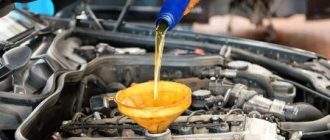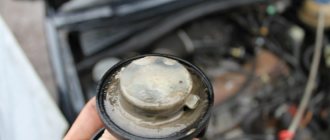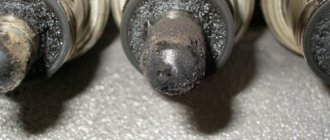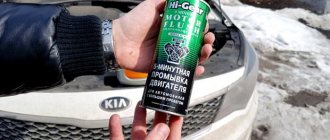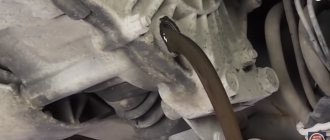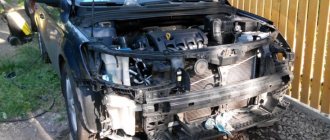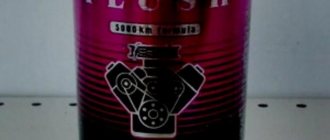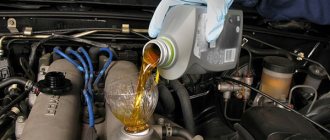Flushing the engine before changing the oil, including scheduled flushing, is not a harmless procedure; it will negatively affect the condition of the internal combustion engine. When drained, up to 10% of the old oil volume remains. If flushing was used, some of it will remain inside the engine crankcase after oil change operations.
This will negatively affect the life of the motor. When it is heavily contaminated, intensive removal of deposits can clog small-diameter lubrication channels, as a result of which the internal combustion engine system may soon fail.
Is it always necessary to flush the engine before changing the oil?
Engine deposits occur for the following reasons:
- use of counterfeit oil or oil with inappropriate characteristics;
- violation of the oil change interval, oil change according to modern regulations (15-30 thousand km);
- engine wear, which causes a large amount of exhaust gases to enter the crankcase.
If you plan to change the oil again, you should evaluate the degree of contamination of the power unit. To do this, you need to remove the filler cap and find out the degree of cleanliness of the parts. If there is no obvious contamination in the form of thick deposits, then there is no need to flush the engine.
If there are a lot of deposits, then it’s worth thinking about - maybe you don’t need to flush the engine, but remove the valve cover and the lower part of the engine crankcase, and manually remove all the dirt that your hand can reach.
This is not a major overhaul, the cost is 2 gaskets and a day of work. This way, most of the deposits will be removed and will not clog small-diameter technological lubrication channels. Accordingly, the risk of early engine failure is minimized.
Let's summarize.
As you can see, the old saying is confirmed again: “Too much of a good thing is also not good!” If you perform flushing, as they say, “should and don’t,” you can achieve the opposite effect and cause harm to the “heart” of your car. If you care about the health of your car’s engine, it will be enough to simply monitor its condition during, or better yet, change the engine oil ahead of schedule, and also do not pour low-quality engine oil into the engine. If the issue of flushing does arise, then I advise you to trust the professionals; they will certainly know how to properly flush the engine of your car.
A classic of the Soviet automobile industry, the VAZ 2106, has earned the love of car enthusiasts as a cheap car to maintain. Most often, owners try to carry out repairs and maintenance themselves. Changing the engine oil is one of these maintenance operations that you can do yourself if you carefully follow the instructions.
How to flush the engine
There are two types of flushes:
- special cleaning oils,
- additives to old oil.
Flushing compounds wash out deposits well, but do not have sufficient lubricating properties. The engine wears out intensively when running on such oil. Additives for old oil can react chemically with it, which can also cause negative consequences.
If you decide to use this type of rinsing, you should read the instructions for the product used. Let us dwell on washing options that have a long history.
Flushing the engine with diesel fuel before changing the oil
Diesel oil softens deposits, but is not able to dissolve them. After washing with diesel fuel, there is a high probability of clogging the oil receiver mesh filter. As a result, the engine will experience oil starvation and accelerated wear of friction pairs. Diesel oil is good for cleaning the parts of a disassembled engine, but you should not use it during the next oil change.
Flushing with gasoline
Gasoline has a negative effect on oil seals and is a flammable liquid. You should not flush the engine with it before replacing it.
However, during the operation of worn-out gasoline engines in winter, when driving mainly short distances on a cold engine, a lot of fuel gets into the oil, and it does not have time to evaporate. Therefore, you can artificially create such a situation when changing the oil.
To do this, on a cold engine, remove the oil level dipstick and fill in about 5-10% of the oil fill volume. This is the only way to fill gasoline, and not through the standard oil filler neck.
Then insert the dipstick into place, start the engine and let it run for 10 minutes. Then turn off the engine and drain the oil. This method is only suitable for gasoline power units.
This is an inexpensive way to flush gasoline engines, and it certainly does no more harm than using various flushing additives—five minutes. The oil will become thinner and the gasoline will wash away any deposits. This method cannot be used for diesel engines.
How to flush the engine from emulsion, dirt and deposits
It is quite obvious that if you need to wash the engine from the inside, then you need a good engine flush. There are a large number of different formulations on sale.
In practice, all products can be divided into two groups:
- additives for mining;
- flushing oils;
However, choosing the best engine flush product is not so easy. First of all, you need to proceed from the specific situation. If you just need to flush the lubrication system before changing the oil, and we are not talking about removing remnants of an emulsion or counterfeit product, then a regular “five-minute” may be quite enough.
The only thing is that this method should be used with caution on old engines. The fact is that over long runs the unit will definitely be dirty, while the “five-minute” ones are very aggressive and separate accumulated deposits in the pan, but do not dissolve them. Such deposits may well clog the oil receiver with all the ensuing consequences.
It should also be remembered that quick flushes in oil can also have a negative effect on gaskets, seals and other seals. There have been cases where, after applying oil flushes, the engine began to leak.
- In case of more serious contamination, it is better to use ready-made flushing oils, which are poured into the engine in full instead of base oil. Depending on the type of flushing composition, the unit should either operate only at idle speed, or short-term driving with minimal loads on the internal combustion engine is allowed.
This type of washing is less aggressive to rubber seals compared to “five-minute” ones, and also more thoroughly washes away dirt and deposits. We also note that flushing oils can be synthetic, semi-synthetic or mineral, and are also universal. In other words, they can be used in both gasoline and diesel internal combustion engines.
We also recommend reading the article on how to flush the engine before changing the oil. From this article you will learn about the available methods and means for flushing the engine.
In practice, this solution can be considered optimal for flushing the engine from emulsion after antifreeze or antifreeze gets into the lubrication system. Flushing oils are also better suited for cleaning dirty internal combustion engines with high mileage.
At the same time, the risk of “clogging” the channels and filters (for example, in hydraulic compensators, the oil receiver mesh) with soggy dirt is still present, but it is not as high as compared to a quick rinse in engine oil.
How to flush the engine when changing the oil
If a flushing additive is used, it is poured through the oil filler hole. The engine is started and allowed to run for the time recommended by the manufacturer of the flushing composition. Then the engine is turned off, the old oil is drained, the oil filter is replaced and new oil is added.
If flushing oil is used, then the old motor oil is drained and flushing oil is added. Then drive the car for the washing distance recommended by the manufacturer. Afterwards the oil is drained, the oil filter is changed and new oil is added.
Reviews from motorists who have tried the diesel fuel flushing method
Good reviews about the method of washing an engine with diesel fuel are mainly left by owners of outdated equipment. For example, drivers often wash ZMZ and VAZ engines with diesel fuel. Here, in most cases, there are no pronounced negative consequences. Although it is not a fact that in one wash the car owner did not reduce the engine life of thousands by 50 km.
You can also find negative reviews on the Internet. For example, after filling with diesel fuel, the engine seized. After disassembly, worn out and twisted liners were discovered.
Therefore, the conclusion about this method of cleaning the engine is this: you can use diesel fuel, but carefully and only on well-preserved outdated engines.
«>
When to rinse
The best way to flush is to change the oil more frequently. The oil should be changed at least once a year. Despite manufacturers' recommendations, it is optimal to change the oil and oil filter after 7.5 thousand km.
At the same time, you should not constantly change the brand of oil - it is better to choose one and constantly use it. In this case, the remnants of the old oil will not negatively affect the composition of the new one. The oil will not have time to wear out and form solid deposits in the engine structure.
When designing the power unit, the manufacturer calculated the optimal characteristics of the lubricating oil. Washing work is not provided. Therefore, they should not be used without good reason. Only a “doctor” (a qualified mechanic mechanic) can prescribe “treatment” for an engine by flushing.
Engine flushing requirements
When is it necessary to flush the engine? As a rule, experts recommend doing this work in the following cases:
- When filling in a lubricant from another manufacturer or brand of motor oil;
- when changing viscosity or type (for example, when instead of “mineral water” you fill in “synthetic” or vice versa);
- if there is a suspicion that low quality fuel or antifreeze has entered the power unit. In addition, flushing the engine is mandatory if you accidentally pour low-quality oil or a completely different composition into the neck;
- if there are doubts about the timing of the last replacement (for example, when buying a car second-hand);
- after any repair work on the engine related to the repair of the cylinder head. This is explained by the fact that during repairs there is a high probability of various “garbage” getting into the oil.
Thus, the question of the importance, benefit or danger of flushing the power unit after using old oil remains open. Both options (with and without flushing) have their own characteristics, pros and cons.
Here, every car enthusiast must figure out for himself how clogged the engine is, when the last oil change was made, what type of lubricant was used, and which one needs to be filled.
At the same time, you must understand what risks exist for the engine in a given case. Good luck on the roads and of course no breakdowns.
There are two types of SOD purification:
External - when insects, dust, oily stains, dirt and other nasty things are removed from the surface of the radiator. Typically, this cleaning is done using a jet and car shampoo.
Dirty radiator - poor cooling
Internal - provides for the removal of deposits consisting of rust, scale, antifreeze decomposition products and rubber parts from the engine cooling jacket and radiator. In addition, contamination and scale are possible in cases where the car owner uses ordinary tap water as coolant. This should not be done under any circumstances, since such water contains a huge amount of salts, impurities and various substances, which, when heated, are deposited on the walls of the cooling system in the form of plaque, complicating heat transfer and reducing the cross-section of the SOD passages.
Lada 2109 Bright blue metallic › Logbook › Flushing the cooling system of a VAZ 2109
Hi all. It all started with the fact that my heater radiator was leaking, and after replacing it (I will write about the replacement in the next article), I decided to thoroughly flush the entire cooling system. What was ultimately purchased:
1. Antifreeze Dzerzhinsky A-40M EXTRA 10 kg. 2. Cooling system cleaner MANNOL 9965.
Now I will describe the entire process of my first replacement of antifreeze and flushing the cooling system.
I poured a flushing agent into the old brake fluid, started the car, turned the heater on as high as possible and let it run for about 20-30 minutes. After that, after waiting for the engine to partially cool down, I stocked up with cut-off plastic bottles and a basin for draining, and I also covered the generator so that liquid would not accidentally get on it. I unscrewed the drain plug on the radiator, placed a cut bottle and, by slightly unscrewing the cap of the Antifreeze tank, began to drain the old liquid. I explain that when you start to unscrew the cap on the tank a little, the pressure of the draining Antifreeze becomes stronger, and after the full half of the cut bottle is filled, you screw the cap on the tank back and the pressure becomes barely. When I drained it, I tried to make sure that it flowed out as little as possible, and that’s practically what happened))). After that, I screwed the plug back and began to drain the antifreeze from the engine itself. I also found the fluid drain bolt and unscrewed it with a 13mm wrench and also by unscrewing and tightening the tank cap I drained the antifreeze from there too. Of course, I had to drain it more than once; apparently the cooling system had not been flushed for a very, very long time.
When I cleaned the system with manol, the drained liquid was of this color:
After that, I started filling the cooling system with water and starting the car in the same way, warming it up, then draining and draining until I had more or less clear water in my basin.
The first flush with water, after cleaning the cooling system with manol. I took the photo in the evening, so in some photos the water may seem either dirtier or clearer
When I drained it the last time, the water turned out to be more or less transparent, this is the result I was trying to achieve
In the second and third photos, I drained the antifreeze only from the radiator, because... on the engine, I could not unscrew the drain bolt, and in the 3rd photo and subsequent ones I drained the antifreeze completely. After each fill of a new batch of water, I pressed on 2 hoses, on the hose that comes from the thermostat and on the hose that goes from the engine to the radiator, and I did this in order to expel air from the system.
After the entire procedure, the heater began to heat better, the car stopped overheating in the summer heat, otherwise previously it was necessary to turn on the cooling fan and the heater at 1st speed to avoid overheating.
In total, I had to rinse 9 times to get almost clean water. Even though I did this whole procedure and replaced the radiator with a new one, the side nozzles still blow barely warm air. Who can say anything about this? All peace and goodness.)))
Like 21 Subscribe
Simple cleaning products
Almost every owner has distilled water available. It is quite suitable for cleaning the system from simple contaminants. The water washing process is carried out in the following order:
These steps must be repeated until the water is clear when drained. This method will not help get rid of contaminants such as scale or rust.
You can also use lactic acid, caustic soda or vinegar to flush the cooling system. These products need to be mixed with distilled water, and then the same steps described above are performed. There should not be too much acid, otherwise such a solution can damage the rubber and plastic elements of the car. At the end of the procedure, you need to fill in clean distilled water, which is necessary to clean the system of residual solution.
